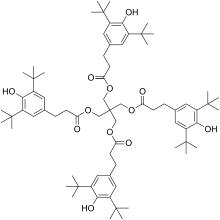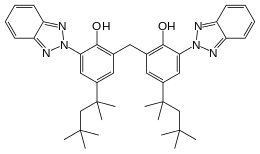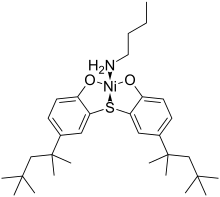Polymer stabilizers
Stabilizers are a class of chemical additives commonly added to polymeric materials, such as plastics, to inhibit or retard their degradation.[1] Polymers can be subject to various degradation processes, including oxidation, UV-damage, thermal degradation, ozonolysis, or combinations thereof like photo-oxidation.[2] These processes all degrade the polymer on a chemical level, leading to chain scission that can adversely affect its mechanical properties such as strength and malleability, as well as its appearance and colour.
A vast number of chemically distinct polymers exist, with their degradation pathways varying according to their chemical structure, as such an equally wide range of stabilizers exists. The market for antioxidant stabilisers alone was estimated at US$1.69 billion for 2017.[3]
Overview
Stabilizers for polymers are used directly or by combinations to prevent the various effects such as oxidation, chain scission and uncontrolled recombinations and cross-linking reactions that are caused by photo-oxidation of polymers. Polymers are considered to get weathered due to the direct or indirect impact of heat and ultraviolet light. The effectiveness of the stabilizers against weathering depends on solubility, ability to stabilize in different polymer matrix, the distribution in matrix, evaporation loss during processing and use. The effect on the viscosity is also an important concern for processing.
Heat stabilizers are mainly used for construction products made of polyvinyl chloride, for instance window profiles, pipes and cable ducts. Light stabilizers, for instance HALS, are especially needed for polypropylene and polyethylene. The environmental impact of stabilizers for polymers can be problematic because of heavy metal content. In Europe lead stabilizers are increasingly replaced by other types, for example calcium-zinc stabilizers.[4]
Antioxidants
Antioxidants inhibit autoxidation that occurs when polymers reacts with atmospheric oxygen. For some compounds this can happen gradually at room temperature but almost all polymers are at risk of thermal-oxidation when they are processed at high temperatures. The molding or casting of plastics (e.g. injection molding) require them to be above their melting point or glass transition temperature (~200-300 °C) and under these conditions reactions with oxygen occur much more rapidly. Once initiated, autoxidation proceeds via a free radical chain reaction which can be autocatalytic. As such, even though efforts are usually made to reduce oxygen levels, total exclusion is often not achievable and even exceedingly low concentrations of oxygen can be sufficient to initiate degradation. Sensitivity to oxidation varies significantly depending on the polymer in question; without stabilizers polypropylene and unsaturated polymers such as rubber will slowly degrade at room temperature where as polystyrene can be stable even at high temperatures.[5] Antioxidants are of great importance during the process stage, with long-term stability at ambient temperature increasingly being supplied by hindered amine light stabiizers (HALs). Antioxidants are often referred to as being primary or secondary depending on their mechanism of action.
Primary antioxidants (radical scavengers)

Primary antioxidants act as radical scavengers and remove peroxy radicals (ROO•), as well as to a lesser extent alkoxy radicals (RO•), hydroxyl radicals (HO•) and alkyl radials (R•). Oxidation begins with the formation of alkyl radials, which react very rapidly with molecular oxygen (rate constants ≈ 107–109 mol–1 s–1) to give peroxy radicals,[6] these in turn abstract hydrogen from a fresh section of polymer in a chain propagation step to give new alkyl radials.[7] The overall process is exceedingly complex and will vary between polymers but the first few steps are shown below in general:
- R → R•
- R• + O2 → ROO•
- ROO• + RH → ROOH + R•
Due to its rapid reaction with oxygen the scavenging of the initial alkyl radical (R•) is exceedingly difficult and can only be achieved using specialised antioxidants baring reactive groups, such as acryloyls,[8] the majority of primary antioxidants react instead with the longer lasting peroxy radicals (ROO•). Hydrogen abstraction is usually the rate determining step in the polymer degradation and the peroxy radicals can be scavenged by hydrogen donation from an alternative source, which converts them into organic hydroperoxides (ROOH). The most important commercial stabilzers for this are hindered phenols such as BHT or analogues thereof and secondary aromatic amines such as alkylated-diphenylamine. Amines are typically more effective, but tend to cause discoloration, which is often undesirable (i.e., in food packaging, clothing). The overall reaction with phenols is shown below:
- ROO• + ArOH → ROOH + ArO•
- ArO• → nonradical products
The end products of these reactions are typically quinones, which may also impart unwanted colour. Modern phenolic antioxidants often have a propionate-group at the para position of the phenol (i.e. they are ortho-alkylated analogues of phloretic acid) as the quinones of these can rearrange once to give a hydroxycinnamate, regenerating the phenolic antioxidant group and allowing further radicals to be scavenged.[9] Ultimately however, primary antioxidants are sacrificial and once they are fully consumed the polymer will being to degrade.
Secondary antioxidants (hydroperoxides scavengers)

Secondary antioxidants act to remove organic hydroperoxides (ROOH) formed by the action of primary antioxidants. Hydroperoxides are less reactive than radical species but can undergo hemolytic bond breaking to form new radicals. As they are less chemically active they require a more reactive antioxidant. The most commonly employed class are phosphite esters, often of hindered phenols e.g. Tris(2,4-di-tert-butylphenyl)phosphite. These will convert polymer hydroperoxides to alcohols, becoming oxidized to organophosphates in the process:[10][11]
- ROOH + P(OR')3 → OP(OR')3 + ROH
Transesterification can then take place, in which the hydroxylated polymer is exchanged for a phenol:[12]
- ROH + OP(OR')3 → R'OH + OP(OR')2OR
This exchange further stabilizes the polymer by releasing a primary antioxidant, because of this phosphites are sometimes considered multi-functional antioxidants as they can combine both types of activity. Organosulfur compounds are also efficient hydroperoxide decomposers, which thermally stabilize the polymers. Sulfuric acids are produced as the product of decomposition, which catalyse further hydroperoxide decomposition.[13]
Antiozonant

Antiozonants prevent or slow down the degradation of material caused by ozone. This is naturally present in the air at very low concentrations but is exceedingly reactive, particularly towards unsaturated polymers such as rubber, where it causes ozone cracking. The mechanism of ozonolysis is different from other forms of oxidation and hence requires its own class of antioxidant stabilizers. These are primarily based on p-phenylenediamine and work by reacting with ozone faster than it can react with vulnerable functional groups in the polymer (typically alkene groups). They achieve this by having a low ionization energy which allows them to react with ozone via electron transfer, this converts them into radical cations that are stabilized by aromaticity. Such species remain reactive and will react further, giving products such as 1,4-benzoquinone, phenylenediamine-dimers and nitroxyl radicals.[14][15] Some of these products can then be scavenged by antioxidants.
Light stabilizers

Light stabilizer are used to inhibit polymer photo-oxidation, which is the combined result of the action of light and oxygen. Like autoxidation this is a free radical process, hence the antioxidants described above are effective inhibiting agents, however additional classes of additives are also beneficial, such as UV absorbers, quenchers of excited states and HALS.
UV absorbers
The UV absorbers dissipate the absorbed light energy from UV rays as heat by reversible intramolecular proton transfer. This reduces the absorption of UV rays by the polymer matrix and hence reduces the rate of weathering. Typical UV-absorbers are oxanilides for polyamides, benzophenones for PVC, benzotriazoles and hydroxyphenyltriazines for polycarbonate.
Strongly light-absorbing PPS is difficult to stabilize. Even antioxidants fail in this electron-rich polymer. The acids or bases in the PPS matrix can disrupt the performance of the conventional UV absorbers such as HPBT. PTHPBT, which is a modification of HPBT are shown to be effective, even in these conditions.[16]
Quenchers

Photo-oxidation can begin with the absorption of light by a chromophore within the polymer (which may be a dye or impurity) causing it to enter an excited state. This can then react with ambient oxygen, converting it into highly reactive singlet oxygen. Quenchers are able to absorb energy from excited molecules via a Förster mechanism and then dissipate it harmlessly as either heat or lower frequency fluorescent light. Singlet oxygen can be quenched by metal chelates, with nickel phenolates being a common example.[17]
Hindered amine light stabilizers
S-1_100.svg.png)
The ability of hindered amine light stabilizers (HALS or HAS) to scavenge radicals produced by weathering, may be explained by the formation of aminoxyl radicals through a process known as the Denisov Cycle. The aminoxyl radical (N-O•) combines with free radicals in polymers:
N-O• + R• → N-O-R
Although they are traditionally considered as light stabilizers, they can also stabilize thermal degradation.
Even though HALS are extremely effective in polyolefins, polyethylene and polyurethane, they are ineffective in polyvinyl chloride (PVC). It is thought that their ability to form nitroxyl radicals is disrupted. HALS act as a base and become neutralized by hydrochloric acid (HCl) that is released by photooxidation of PVC. The exception is the recently developed NOR HALS, which is not a strong base and is not deactivated by HCl.[18]
Other Classes
In addition to the effects of light and oxygen polymers may also be degraded by various other environmental factors
Acid Scavengers
Acid scavengers, also referred to as antacids, neutralize acidic impurities, especially those that can act as a source of HCl. They are important stabilizers in many types of polymer, particularly PVC, as well as those produced using Ziegler–Natta catalysts, or that use brominated or chlorinated flame retardants. Common examples include metallic soaps, such as calcium stearate, mineral agents like hydrotalcite and hydrocalumite, and basic metal oxides such as zinc oxide.
Heat stabilizers
Heat (or thermal) stabilizers are mostly used for PVC, as unstabilized material is particularly prone to thermal degradation. These agents minimize loss of HCl, a degradation process that starts above 70 °C. Once dehydrochlorination starts, it is autocatalytic. Many diverse agents have been used including, traditionally, derivatives of heavy metals (lead, cadmium). Increasingly, metallic soaps (metal "salts" of fatty acids) are favored, species such as calcium stearate.[19] Addition levels vary typically from 2% to 4%. The choice of the best heat stabilizer depends on its cost effectiveness in the end use application, performance specification requirements, processing technology and regulatory approvals.
Flame retardants
Flame retardants are a broad range of compounds added to polymers to improve fire resistance.
Biocides
Degradation resulting from microorganisms (biodegradation) involves its own class of special bio-stabilizers and biocides (e.g. isothiazolinones).
See also
References
- ↑ Zweifel, Hans; Maier, Ralph D.; Schiller, Michael (2009). Plastics additives handbook (6th ed.). Munich: Hanser. ISBN 978-3-446-40801-2.
- ↑ Singh, Baljit; Sharma, Nisha (March 2008). "Mechanistic implications of plastic degradation". Polymer Degradation and Stability. 93 (3): 561–584. doi:10.1016/j.polymdegradstab.2007.11.008.
- ↑ "Plastic antioxidants market projected to reach US$2.11 billion by 2022". Additives for Polymers. 2018 (2): 10. February 2018. doi:10.1016/S0306-3747(18)30046-0.
- ↑ http://www.ceresana.com/en/market-studies/additives/stabilizers/ Market Study: Stabilizers by Ceresana Research, May 2011.
- ↑ Geuskens, G.; Bastin, P.; Lu Vinh, Q.; Rens, M. (July 1981). "Photo-oxidation of polymers: Part IV—Influence of the processing conditions on the photo-oxidative stability of polystyrene". Polymer Degradation and Stability. 3 (4): 295–306. doi:10.1016/0141-3910(81)90025-2.
- ↑ Ingold, Keith U. (May 2002). "Peroxy radicals". Accounts of Chemical Research. 2 (1): 1–9. doi:10.1021/ar50013a001.
- ↑ Lucarini, Marco; Pedulli, Gian Franco (2010). "Free radical intermediates in the inhibition of the autoxidation reaction". Chemical Society Reviews. 39 (6): 2106. doi:10.1039/B901838G.
- ↑ Yachigo, Shin'ichi; Sasaki, Manji; Ida, Kanako; Inoue, Kikumitsu; Tanaka, Shin'ya; Yoshiaki, Honda; Emiko, Fukuyo; Kazunori, Yanagi (January 1993). "Studies on polymer stabilizers: Part VI—Relationship between performance and molecular conformation". Polymer Degradation and Stability. 39 (3): 329–343. doi:10.1016/0141-3910(93)90009-8.
- ↑ Gijsman, Pieter (2018). "Chapter 18 - Polymer Stabilization". Handbook of Environmental Degradation of Materials (Third ed.). William Andrew Publishing. p. 375. ISBN 9780323524728.
- ↑ Schwetlick, K. (1 January 1983). "Mechanisms of antioxidant action of organic phosphorus compounds". Pure and Applied Chemistry. 55 (10). doi:10.1351/pac198355101629.
- ↑ Schwetlick, K.; König, T.; Rüger, C.; Pionteck, J.; Habicher, W.D. (January 1986). "Chain-breaking antioxidant activity of phosphite esters". Polymer Degradation and Stability. 15 (2): 97–108. doi:10.1016/0141-3910(86)90065-0.
- ↑ Schwetlick, Klaus; Habicher, Wolf D. (October 1995). "Organophosphorus antioxidants action mechanisms and new trends". Angewandte Makromolekulare Chemie. 232 (1): 239–246. doi:10.1002/apmc.1995.052320115.
- ↑ Kröhnke, C. (2016). "Polymer Stabilization". Materials Science and Materials Engineering. doi:10.1016/B978-0-12-803581-8.01487-9. ISBN 9780128035818.
- ↑ Cataldo, Franco; Faucette, Brad; Huang, Semone; Ebenezer, Warren (January 2015). "On the early reaction stages of ozone with N,N′-substituted p-phenylenediamines (6PPD, 77PD) and N,N′,N"-substituted-1,3,5-triazine "Durazone®": An electron spin resonance (ESR) and electronic absorption spectroscopy study". Polymer Degradation and Stability. 111: 223–231. doi:10.1016/j.polymdegradstab.2014.11.011.
- ↑ Cataldo, Franco (January 2018). "Early stages of p-phenylenediamine antiozonants reaction with ozone: Radical cation and nitroxyl radical formation". Polymer Degradation and Stability. 147: 132–141. doi:10.1016/j.polymdegradstab.2017.11.020.
- ↑ Das, P.K.; DesLauriers, P.J.; Fahey, Darryl R.; Wood, F.K.; Cornforth, F.J. (January 1995). "Photostabilization of poly (p-phenylene sulfide)". Polymer Degradation and Stability. 48 (1): 1–10. doi:10.1016/0141-3910(95)00032-H.
- ↑ Zweig, A.; Henderson, W. A. (March 1975). "Singlet oxygen and polymer photooxidations. I. Sensitizers, quenchers, and reactants". Journal of Polymer Science: Polymer Chemistry Edition. 13 (3): 717–736. doi:10.1002/pol.1975.170130314.
- ↑ Cappoci, G and Hubbard, M, 2005, A Radically New UV Stabilizer for Flexible PVC Roofing Membranes, JOURNAL OF VINYL & ADDITIVE TECHNOLOGY, 11, pp 91–94
- ↑ M. W. Allsopp, G. Vianello, "Poly(Vinyl Chloride)" in Ullmann's Encyclopedia of Industrial Chemistry, 2012, Wiley-VCH, Weinheim. doi:10.1002/14356007.a21_717.